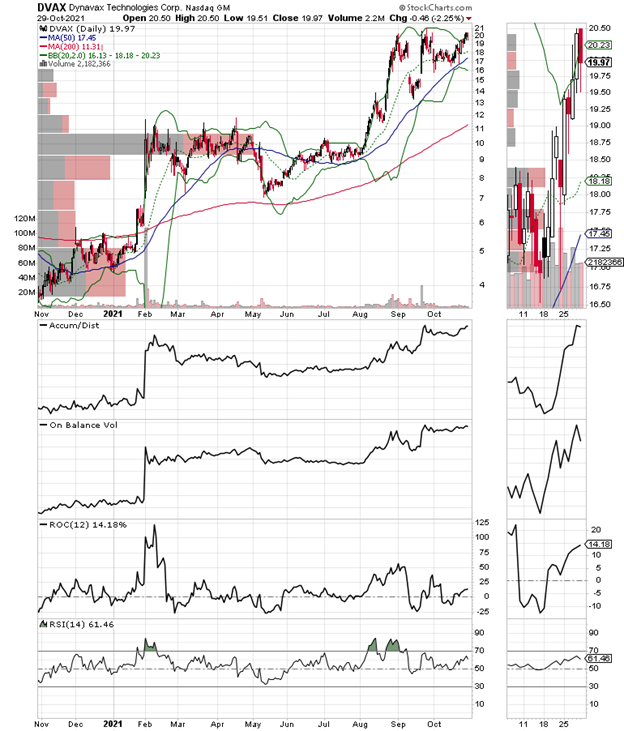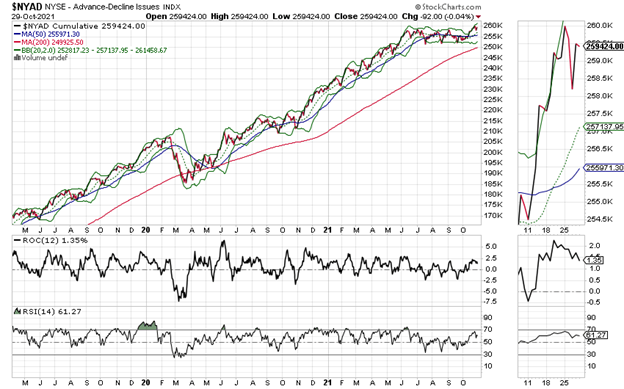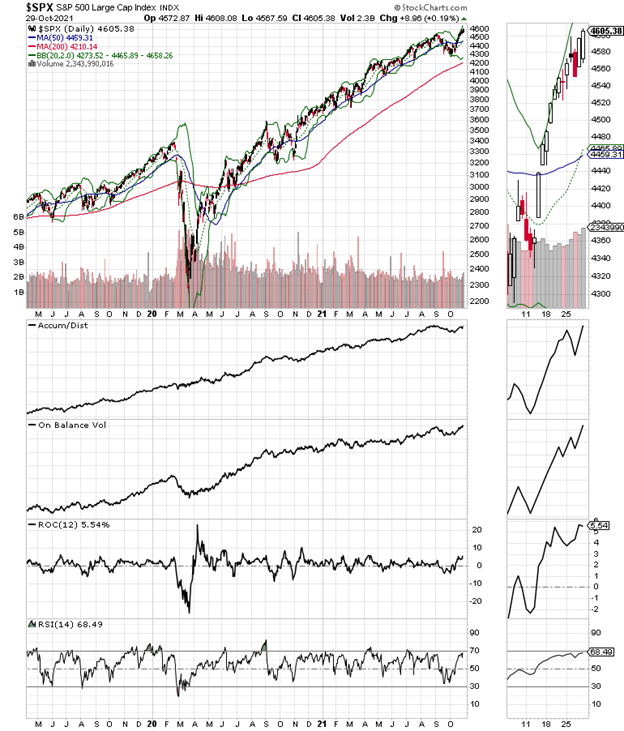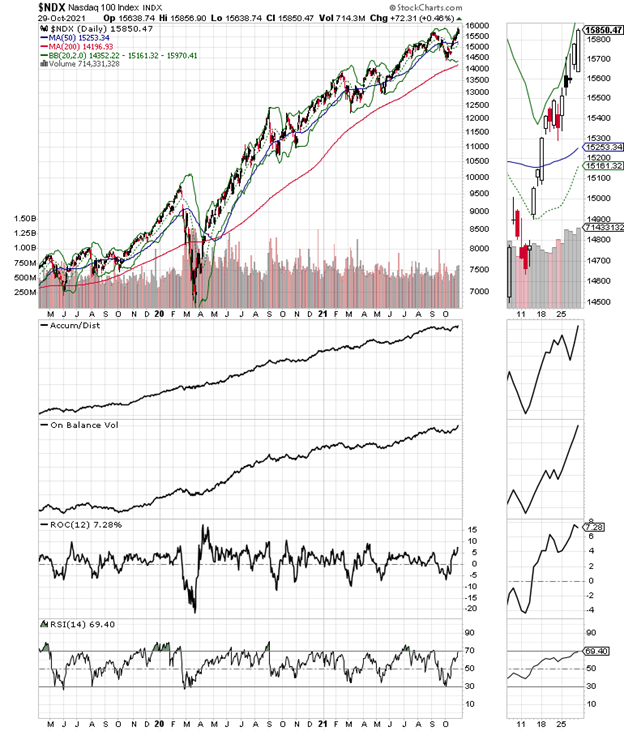The stock market could well crash and burn, today, November 3. But what if it doesn’t, asks Joe Duarte of In the Money Options.
I am expecting a major reaction from the stock market on Wednesday afternoon. And although it could be a negative day, contrary to the prevailing sentiment I would not be surprised if it’s a move to the upside for many stocks. That’s because as I detail below, the action in the market’s breadth and in the SPY options are offering some glimmers of hope.
Therefore, investors should prepare for any potential scenario, as the aftermath of Wednesday’s Federal Reserve Open Market Committee (FOMC) meeting and their decisions QE tapering and the future of interest rates are likely to be pivotal for the MELA system—the markets (M), the economy (E), people’s life decisions (L), and the algos (A).
Last week in this space, I described the relationship between the stock market, the 401(k) plan, the economy, and their influence on people’s life and financial decisions. The short version is that rising stock markets are bullish for 401(k) plans and that the wealth effect created by these gains, in turn, makes people bullish and fuels big purchases, thus creating economic growth.
This week, I will detail the final piece of the MELA puzzle, the algos. And I am doing it from the point of view that even though many are expecting a major market breakdown after the Fed meets, that is not a certain outcome. Therefore, it’s important to understand how algos work and why it is reasonable to entertain the possibility of a positive surprise.
Inside the Algo World and What Could Happen After the Fed’s Announcement
Algos are computer programs that make automated decisions based on instructions fed into them by their programmers, usually highly paid PhD’s with diverse degrees; many in non-Wall Street related fields of study such as statistical analysis and mathematics. These programmers are known on Wall Street as quants.
Once the basic set of instructions is in place, algo make adjust trading decisions based on the outcome of their calculations and the ensuing results of their actions. Their calculations are so numerous and so rapid that humans can’t keep up.
There are two main types of algos: those used by CTAs (commodity trading advisors) and those used by market makers. And while both are programmed based on the “if this happens do this” principle, it’s important to differentiate the two.
In addition, all algos share one characteristic; when they find a formula for success, they keep on executing the program until it stops working. Indeed, this is why algo fueled trends last longer than many expect. It is also why whatever happens on Wednesday could last for quite a while.
CTA Versus Market Makers
Just to keep it simple, we’ll say that CTA algos include hedge funds and just about any big trading operation in the world, especially those on Wall Street and Chicago. These algos are all about responding to headlines and buying and selling assets in response to the headlines, as well as at key market support and resistance levels.
They trade stocks, bonds, currencies, futures, and options; often creating highly sophisticated strategies involving multiple instruments and asset classes in more than one market simultaneously. Moreover, algos often correlate the action between all key markets in order to allocate money and find the mix of assets that will make the most money for the firm.
Market maker algos are the ones that match the buy and sell orders, either in the open market or in dark pools. These are the algos that see the order flow before you and I, and sometimes but not always, before or along with the CTA algos.
Market maker algos, along with matching buy and sell orders, do two things: create trends by adjusting prices in order to keep orders flowing and accentuate any trend by adjusting prices and hedging in ways that protect their accounts.
Many firms are both market makers and CTAs. And the reason why the Fed is central to what’s about to happen is that the one instruction that all trading algos agree on is that simplest of all market adages:
Inside the Machine
So, now that we’ve sorted that out, here’s what’s likely to happen on Wednesday when the Fed makes its announcement and Powell hits the podium for his press conference.
- CTA algos will read the headlines and react based on their version of the “Don’t Fight the Fed” program.
- They will calculate the infinite number of probabilities and possibilities for a profitable outcome and buy or sell aggressively in all pertinent markets according to the solution of their problem, based on their instructions.
- Market maker algos will respond to the order flow by adjusting prices and simultaneously hedging to protect their accounts—this will exaggerate the primary trend; whatever it is.
- The market will move based on the interaction between the CTAs, the market makers, and the rest of us who will have to wait to see what they do before acting.
- Algos don’t care about long-term consequences or the effects of their actions on people. Their only goal is to follow the program and make money.
- All hell may or may not break loose depending on the dominant algo programs and how they affect the market’s trend.
There are still some stocks and option strategies, which may yield sizeable gains when properly managed even in negative markets.
Dynavax: A Stealth Vaccine Play with Upside Momentum
I recently recommended buying shares of vaccine developer Dynavax (DVAX) ahead of its coming earnings because of the potential for an upside surprise.

Certainly, this is not a trade without risk given the fact that DVAX does not produce a Covid-19 vaccine, which clearly has been the golden goose for those companies that have developed them. Moreover, DVAX is a small company with a market cap of only about $2 billion, which could make for sloppy trading.
But here is what I like about this company. Although it doesn’t make a Covid vaccine, it does make a key ingredient used by other companies that do. It’s an adjuvant named CpG 1018—a synthetic DNA compound that accelerates the immune system response from vaccination while allowing vaccine makers to avoid using a live virus or bacterium to make the vaccine—offering some safety offsets.
Moreover, DVAX makes what is becoming the leading Hepatitis B vaccine in the world and is growing its list of customers for CpG 1018 to be used in manufacturing vaccines for pertussis and non-Covid flu vaccines, as well as expanding its Covid vaccine customer list.
As a result, DVAX delivered record revenues in its most recent quarter and has the potential to surprise on the up side when it reports its Q3 results on 11/4/21. DVAX delivered two cents per shares earnings in its past quarter compared to a $0.53 loss in the prior quarter and seems to be entering an earnings growth acceleration phase.
Technically, DVAX looks set to move above $20 in the not-too-distant future, unless something negative develops, such as it misses on its earnings expectations. Accumulation Distribution (ADI) and On-Balance Volume (OBV) are in uptrends, as money is moving in.
I own shares in DVAX as of this writing.
Options Traders Turned Slightly Bullish Last Week
In a reversal of the prior week’s heavy put buying, SPY options traders increased their call buying on Friday’s weekly expiration. It’s hard to make sense of this because the Fed meeting is coming up and things may change.
In other words, if by any chance the market’s response to whatever the Fed says is positive, the ensuing market rally may be quite impressive.
Market Breadth Has Some Stealth Bullishness
The new high in the New York Stock Exchange Advance Decline line (NYAD) of two weeks ago did not follow through this week. But it did not fall apart altogether as NYAD remained within striking distance of it and remained above its key moving averages.

The S&P 500 (SPX) made a new high on 10/29 and remained above 4500 as well as its 20,50, 100, and 200-day moving averages with good confirmation from Accumulation Distribution (ADI) and On-Balance Volume (OBV).

The Nasdaq 100 index (NDX) also made a new high despite declines in post earnings Amazon.com (AMZN) and Apple (AAPL). Moreover, the NDX breadth line made a new high, with Accumulation Distribution (ADI) and On-Balance Volume (OBV) confirming.

To learn more about Joe Duarte, please visit JoeDuarteintheMoneyOptions.com.




















